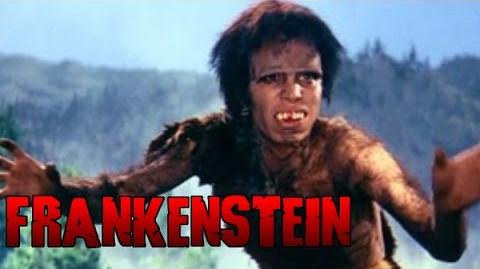Template:Ktab Template:Kaiju Infobox Frankenstein (フランケンシュタイン?, Furankenshutain) is a kaiju used by Toho in the 1965 Toho film, Frankenstein vs. Baragon. Template:TOC
Name
Frankenstein's Japanese name is a rōmaji of his name in English, which was the surname of the monster's creator, Doctor Victor Frankenstein, in Mary Shelley's original novel.
Origins
Frankenstein was a creature created originally by Doctor Victor Frankenstein, who was able to give life to the kaiju after he created it, only for it to be the ultimate reason for his death in a burning windmill. Towards the end of World War II, Hitler's Nazis capture and ship the still living heart of Frankenstein's monster to Japan in order to prevent it from falling into the hands of the Allied forces. The heart is taken to a Hiroshima laboratory for study and is lost and seemingly destroyed when the United States drops the atomic bomb Little Boy on the city. Ten years later, a wild boy is discovered near the ruins of Hiroshima. Scientists eventually capture and study him, discovering that he was regenerated from the lost heart of Frankenstein.
History
Showa Series
Frankenstein vs. Baragon
Ten years after the bombing on Hiroshima, a wild boy is discovered near the ruins of Hiroshima. Scientists capture and study him, discovering that he was regenerated from the heart of Frankenstein. Frankenstein is well fed by the scientists, and in response to the protein-rich food, begins to grow incredibly fast, reaching a height of 20 meters with extraordinary speed, forcing the scientists to incarcerate him in a cell. However, Frankenstein manages to escape his prison, his hand actually snapping off when his chains became too tight. Frankenstein then flees to the Japanese countryside, sending all of Japan into a panic and being blamed for the disappearance of both livestock and people. It is later discovered that the people have been eaten not by Frankenstein, but by a new, burrowing kaiju named Baragon, who has eluded detection for quite some time. However, when Baragon attacks one of the scientists who cares for Frankenstein, the human-like monster attacks him. A vicious battle ensues, ending when Frankenstein apparently having killed Baragon by breaking his neck. Frankenstein, however, does not have long to savor the victory, for the ground underneath him, which has already been weakened by Baragon's burrowing, gives way and sends Frankenstein into the bowels of the Earth. Due to his incredible regenerative ability, it has been suggested he was trapped forever in constant pain.
Gallery
- Main article: Gallery:Frankenstein.
Roar
Trivia
- In the alternate ending for Frankenstein vs. Baragon, after Frankenstein defeats Baragon, the Giant Octopus comes from the sea and fights Frankenstein. Frankenstein battles fiercely, but can't compete with the Giant Octopus's numerous and powerful tentacles. The Giant Octopus drags Frankenstein in to the water, seemingly to his death.
- In Frankenstein vs. Baragon, Dr. Victor Frankenstein is referred to as "a German scientist." According to Mary Shelley's original novel, Victor Frankenstein was born in Naples, Italy, and was raised in Geneva.
- Many Toho films released after 1965 were released in Germany as Frankenstein films, many sporting the name in their titles.
- In the German release of many Godzilla films, it is explained that most of the monsters that Godzilla fights are created by Doctor Victor Frankenstein.
- Frankenstein's monster was originally going to fight Godzilla in King Kong vs. Godzilla. In an earlier draft, the monster was going to fight King Kong. In the German release of the film Frankenstein was put into the plot.
- In the original novel as well as the first films by Edison Studios and Universal, the monster was referred to as "Frankenstein's monster", "the Frankenstein monster", or just "the monster", but never "Frankenstein." The monster's name being "Frankenstein" has been a very popular misconception that has been around for more than a hundred years. Toho's version of the monster is explicitly called "Frankenstein," so in the context of Toho's films related to the Frankenstein monster, the monster being called by "Frankenstein" is nevertheless correct.
Also See
Template:TohoMonsters
Poll
Template:Era

